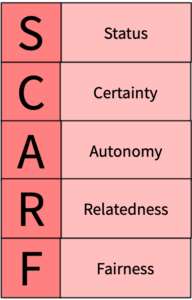When we talk about leadership, we distinguish four traits:
For a given position, I have an appropriate mix of responsibilities and I need an appropriate mix of skills and talents.
Situational awareness is the perception of environmental elements and events in relation to time or space, the understanding of their meaning, and the projection of their future status.
Situational awareness is a critical foundation for successful decision making. A lack of situational awareness is one of the most important factors in – sometimes momentous – wrong decisions.
As leaders, we need to adapt to complex environments – this is true at every level, for personal, team, strategy and product decisions, and understanding the situation is the indispensable first step.
Being goal oriented sounds so simple and yet is so often neglected.
Start with Why is Simon Sinek’s mission to help and inspire others at work.
He has three lessons on how to communicate and how you can adjust your mindset to inspire yourself and others.
3 lessons you should take away from Start with Why:
Trust is often demanded – but it is not a one-way street.
Trust – or the absence of trust – has an immense impact on the nature of collaboration.
People are treated like children in the company – at home they raise children and build houses.
They are expected to be entrepreneurial and are not trusted to order books on their own.
If you want to build trust, there are clear conditions, and behaviors that need to be in place for that to happen successfully.
Authentic leaders are positive people with realistic concepts about themselves. They promote openness. Authentic leaders are able to improve individual and team performance by building trust and gaining enthusiastic support from their subordinates and peers.
Here are some concepts to help you assess yourself and better understand what you should be working on.

Underlying the demand for a psychologically safe environment are three central ideas:
As a leader, I often have the reflex to take things into my own hands or determine exactly how they should be implemented – after all, in technology companies in particular, the fact that I’m good at this is often the reason I get promoted. So nothing could be further from the truth.
There’s a catch, though: it doesn’t scale and it ignores the essential reason I’m a leader: I don’t lead.
In this chapter we talk about ways out of this trap. How do I do what is best for the effectiveness of thees overall system? What is the best way to develop my employees? How do I become a catalyst for them and my area of responsibility?
If I want to implement my role as a catalyst, the most important element is that I get involved with people. Develop empathy while being – as we have seen – authentic and consistent.
The next question is what my goal statement is: I want to focus everyone on advancement and help them deal constructively with obstacles and mistakes. In English, one also speaks of a “growth mindset”.
Finally, I need tools for the most important interaction: the conversation. We will discuss one technique (“ORID”) here as an example.
How do I make an impact? It is helpful to be aware of the ways in which my actions (and, as a basis, my thinking) affect me.
Certain aspects are general: people make experiences, they adjust their behaviour accordingly. In the long run, this influences opinion about what is “normal” – as a collective opinion, we call this culture.
Of course, things are not so simple and unidirectional, but interactive and cyclical, so there’s plenty of material for discussion here. In the team context, the focus is on interactions (and some structures, such as the aforementioned Safe Space); in the corporate context, the focus shifts to structures, policies, governance, and so on.
The whole idea of agility revolves around the shortening of feedback cycles, around better adaptation to new circumstances or: gaining future decision-making bases from the past.
We’re talking about empirical management. of situational awareness, of situational leadership and adaptive strategy – it is always the same basic idea.
Active use of feedback is one of the cornerstones of good agile leadership, if you will.